
How I Won The League With a Counter Attacking 4-3-3 – FM23
My current Journeyman in Football Manager 2023 has made me play different systems. I have never really settled with one particular style, until I took over Radomiak Radom in the Fortuna Liga, Poland. This system won the title and promotion to the PKO Ekstraklasa with a club record breaking 3rd placed finish. Fast forward a year, with a failed spell at Viktoria Plzen, I have took over recently relegated Aston Villa. Where I have recorded a record 110 points, scoring 102 goals, conceding 38 times in the league, with a goal difference of 64. Let’s begin this 4-3-3 Counter Attacking guide.
A big thank you to The Byline event and FM Stag for the much needed motivation to create an article after so long without. I hope you enjoy this, as much as I enjoyed writing it.
The idea behind the Counter Attacking 4-3-3 tactic
Like any journeyman where you start with no badges or qualifications, it’s hard to progress from the ground up whilst trying to keep an identity. In 2029 I decided that we need to stick to a playing style and use this as our base.
I don’t often use an attacking midfielder as I like the extra defensive security that a flat or a DM three offers you. However, I wanted to run with two strikers but have someone drop in the holes between the midfield and defence. This led me to start thinking about a reduced Target Forward in the Attacking Midfield area. That’s essentially what the inspiration of the tactic was for this.
From there it was about putting the pieces together to complete a tactical jigsaw. Although the team has changed since the original idea, the principals have remained the same, and the intent is to be as safe defensively as possible while playing counter attacking football.
I knew I was at a club that would be fighting for promotion in the Polish league system, so I wanted to create a tactic which was good enough for that league. But also good enough to compete in the Ekstraklasa. This is why I wanted to play counter attacking football. Ensuring that we aren’t trying to Dictate the Game (see what I did there), but more about making the most of our chances. Because, at the end of the day, we are under dogs, massively.
I wanted all players to be involved with the phases of play, except my centre backs. This was because at that level their passing and vision wasn’t as good as I wanted them to be. Which means I will have to focus on my wide defenders for the outlet. Eventually I did want to have a player who was in centre back who would play out from the back.
The Attacking Midfielder in the system was to be the spearhead of the team, and be the player that had the most influence in the final third. A Target Man type player, but was also technically gifted so that if the player wasn’t tall/physical, they had the ability to make the right choices on and off the ball.
Playing with a team that wasn’t at the top of the league systems, I knew if I played counter attacking football it would tire the players out more, and that’s why I chose this system, simply to the fact that the team I inherited had a larger squad. This allowed me to chop and change, but also stick to the system I liked. I knew doing this would mean one of my midfielders had to be pressing more, and even though my Ball Winning Midfielder is on Defend, his position is important to us winning the ball back in key areas.
Evolution of the tactic
Firstly, I took a lot of inspiration from Crusadertsar’s defence-first formation and Throwing Copper’s Ultimate Under dog 5-3-2 tactic. Applying the same principals in my Counter Attacking 4-3-3, has allowed me to win with intent.
I have two screenshots of average positions for the two teams, and I’ll go on to explain exactly how I evolved the tactic from a Ekstraklasa 3rd placed finished in the season following our promotion, to our Championship title winning Aston Villa team that broke several records, whilst conceding the least goals all season 4 goals, losing 6 games in 46 and winning the FA Cup final. The base of the formation for both still remains as a Counter Attacking 4-3-3.

This is how I set the team up, and it was very effective at what I wanted it to do. I played with an Inverted Winger on the left and a Winger on the right. I wanted them both to be high up and essentially sitting on their full backs so they didn’t have as much of an opportunity to attacking down the wings, forcing them inside.
As mentioned earlier, I wanted the team to have an Attacking Midfielder who was our target man. We had a 6″6 Attacking Midfielder named Tom Sanne who was playing this role. In this team, Tom scored 11, assisted 5 and won Player of the Match 5 times over the season. These might not seem amazing numbers, but having this outlet allowed us to win the league.
The full backs were defensive, to stop counter attacks and meant we played a very defensive back four, with the left sided centre midfielder playing a really deep Ball Winning Midfielder role. It allowed the front four the freedom to attack, with the right sided centre midfielder playing as a play maker.
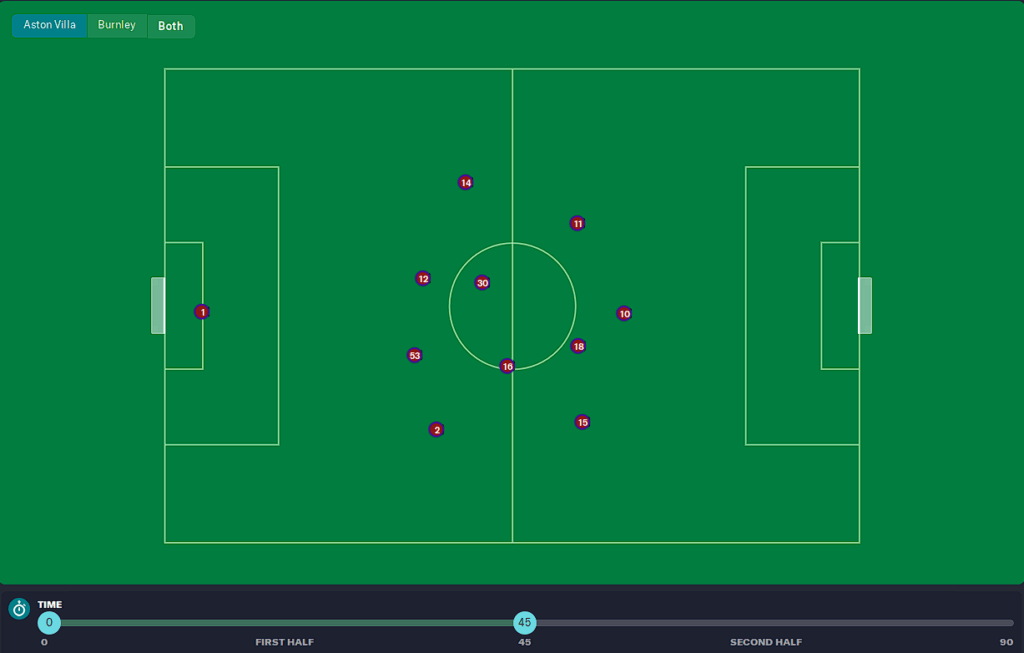
As you can see, this changes quite a bit when at Aston Villa. I wanted to play a lot more narrow, and allowing the Attacking Midfielder, closer and shorter options to play to. We didn’t have an Attacking Midfielder who was as tall as the previous player, but what I did have was very technically gifted players who would provide assists and goals with their footballing ability. I chose Inside Forwards to create little pockets of space in the final third, as well as creating overloads. This meant it would push their midfield deeper to defend against our team, and left us less prone to being overran.
Both rotational players in Attacking Midfield scored a combined 27 goals in the league, which goes back to what I wanted. A Target Man, but an unconventional Target Man.
With Radomiak Radom I didn’t have the players with the ability to play a Ball Playing Defender, but with Aston Villa, I did. This allowed a lot more creativity and importance on building from the back
I pushed the full backs into Wing Backs, because I know we had the ability to push higher up the pitch and not be as exposed at the back. Although they are Wing Backs, there job wasn’t to get assists, but to join the midfield and create triangles between players, especially the Inside Forwards on either side, and the three midfielders.
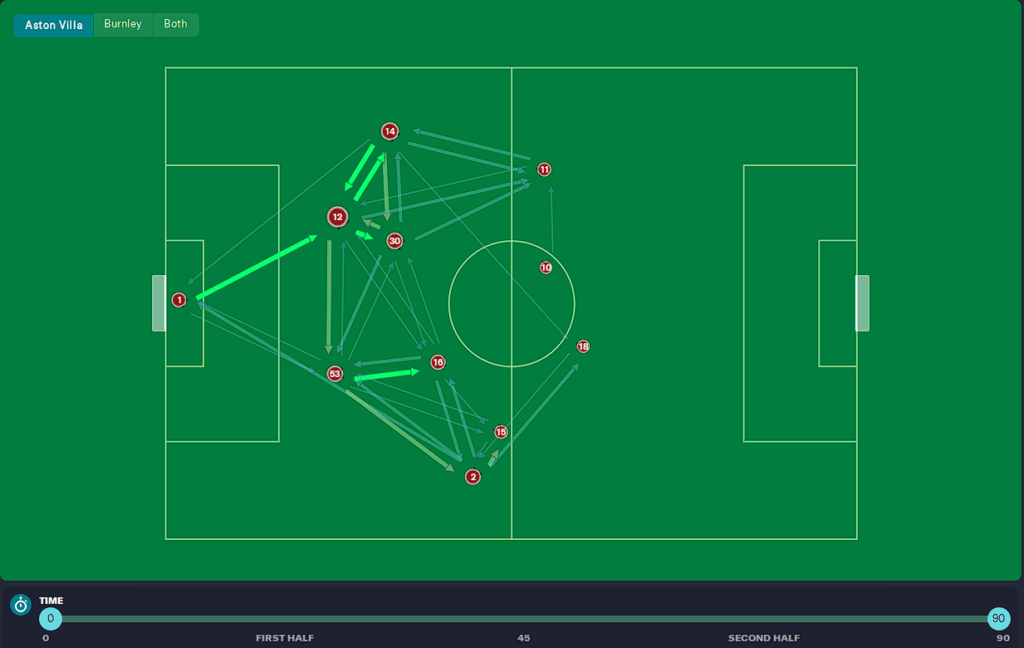
Number 12, our current Ball Playing Defender. This has changed a lot since we changed to a BDP in defence. Number 16 is our Deep Lying Playmaker, who isn’t as involved, but this is not an issue, because the balls are still coming to him. Number 18 is our Attacking Midfielder, who is higher than our Striker, Number 10. This is intentional, as we don’t really want our Striker to be involved in the passing movement, especially being an Advanced Forward.
Despite playing counter attacking, we want to play in a way where it’s not just about getting the ball in the oppositions box, but retaining the ball ready for a counter. This has evolved a lot from essentially going back to front like we did at the previous club.
Pressing with Intent
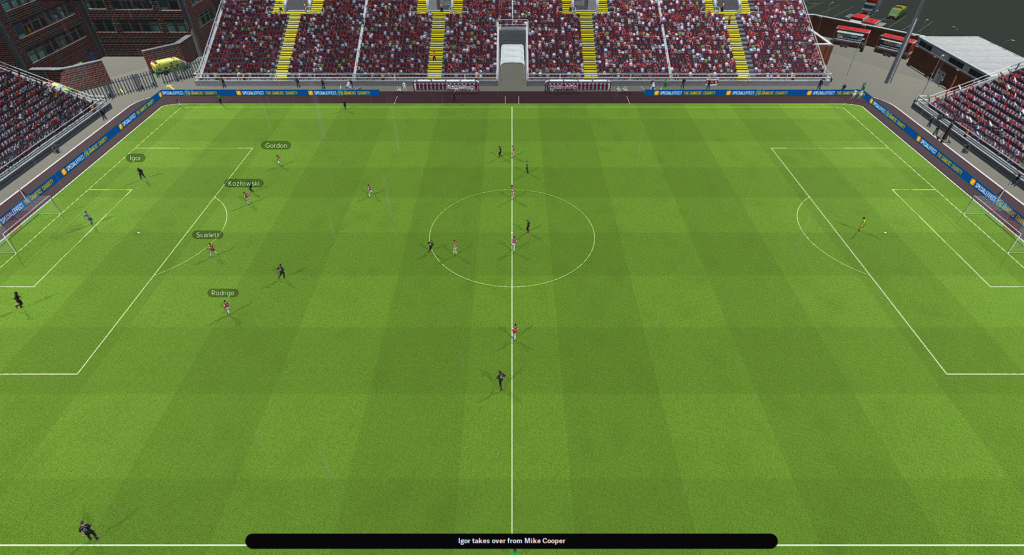
Previously we sat back a little more, and wider, but this time we are playing high and narrow. Although this leaves us open on the wing backs, I believe that when a ball is played there, the players are able to shift across.
From this image, we set up as a 4-2-4. From their goal kicks in the hope that we can prevent them playing short, or press and win the ball back in the tight defensive spaces. In this particular phase of play; they play it to their right winger, who heads the ball into the Midfield where our BWM picks the ball up and creates a chance, where we ultimately get a goal from it as seen in the video below:
This is exactly what I want. I don’t want the ball in our half and this is a prime example of this in practise. It’s not about having possession, it’s about doing the right thing with the ball when we have it.
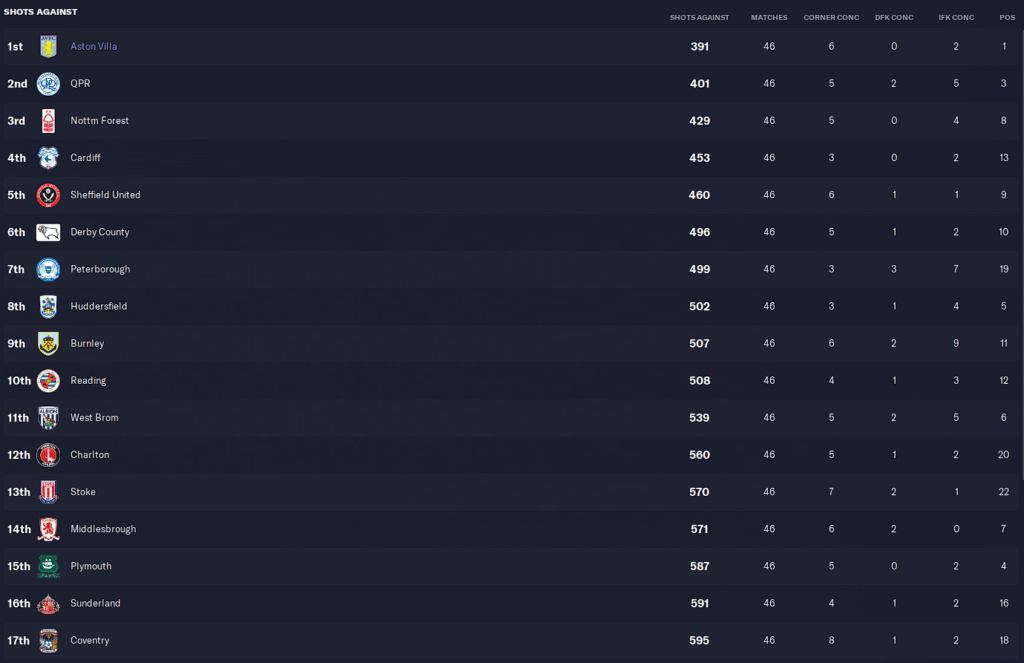
This leads me on to the shots we face. With playing a pressing game, ultimately the aim is to suffocate the opposition with chances, and this is pretty evident in the amount of shots we have faced over the season. We faced on average 8.5 shots per game, which is not bad, considering this takes into consideration shots off target. To put this into perspective, we concede on average a goal every 10.29 shots, which makes for good viewing. This is all contextual, because we are in the Championship. However, this does give me a lot of hope to survive when we go up.
Pressing Statistics

These are the statistics I believe are important for this team. Possession won per 90, Interceptions per 90 and Presses per 90. As counter attacking is the focus, this is exactly what I want to see.
I am particularly interested in the fact that our team presses from the front. This goes back to wanting to keep the ball in the opposition half as much as we can. On this particular screenshot it is only Thiago who is more of our defensive midfielders playing in the Deep Lying Playmaker role. The other players, play in ST, LW, RW and AM.
Focusing on interceptions and using the data we have, our wing backs are the players who intercept the most balls, and after looking at the matches, it is often from Goal Kicks that have been played short and then played out wide. As you seen in the video above, our left back heads the ball to our Centre Midfielder, who sets up a counter attack, which we score from.
The same can be said about possession won, mostly our wing backs are picking the ball up. However, this is spread out a little more between the team where our central midfielders and attacking midfielders are also contributing to this. The only players averaging under 5 per game are both our strikers. This to me is not an issue, unless I was playing with a different striking role, other than an Advanced Forward.
Looking at this, it paints a picture as to what I want the team to be about. I don’t really want my defenders to pick up the ball, when we should be relying on our more attacking outlets to do this. By no means am I saying this tactic is the best thing since sliced bread, but the tactic does everything right.
It’s not about winning the ball back every time we can, it’s about being patient and winning the ball back at the right times, to create counters. Playing a slightly more direct style of play, means despite having more possession than others, we have enough quality to create chances.
Goal Output
When Dane Scarlett scores 51 goals in 46 Championship games, it’s time to identify where and why these goals are happening.

Our striker is in a league of his own, in terms of output from shots taken. A lot of our goals came from over the top through balls where we rely heavily on the strikers pace, and finishing to get the chances and goals we need.
Often the striker can be quite isolated because their sole purpose is to score goals, but you have to be patient with a system like this. It’s not about how many chances we create, it’s about taking the chances we get and punishing the opposition.

I don’t want to keep repeating myself in terms of stopping them from scoring, and ensuring we are scoring. I’ll let the data do the talking for this. Create chances, and stop the opposition from getting chances.

Surprisingly we didn’t score any goals in our own half, which is a shame, as I think the tactic might be broke because of this. I am going to start with the goal times, just to give a little context. We scored the least amount of goals in the latter stages of the game, because often or not we were already in the lead, and playing three times a week. It was about managing players, and the demands the style has on them.
I don’t really look at the type of goals, but more at the spread of where the goals were. I think it’s important to remember that a lot of our goals come from through balls (seen in picture below), so more often than not we try to get in the box to finish these chances.
Collectively this team could score more goals, if we had a set piece master. 1 Free Kick goal in the whole season isn’t much. Analysing why it’s not happening is more important to the task ahead. I would suggest all players check where their goals are coming from and their types to plug the gaps and offer a variety of scoring avenues.

As I alluded to, a lot of our goals come from through balls. This is how we wanted the style to be, a slightly more direct with the intention of getting the ball in behind the striker or attackers. Crossing is another one of our key areas. Having Inside Forwards, this still happens and is something we want.
I quite like the fact that the majority of our goals are assisted from near our own half. This shows that our intention to win the ball back is important, but also creating counters for this. The weakest area is our left inside forward, who plays as support. This is more to do with the balancing act and not having an overload which leaves spaces in key areas. This is of no concern as we are the top scorers in the league, and the importance for is having a variety.
In my previous job, a lot more goals were from headers. But it’s always about adapting to become a better team. If we signed a tall attacking midfielder, we would be looking at more headed goals. That creates a slightly different balance in terms of goal distribution.
Breakdown of the Counter Attacking 4-3-3 formation

This example is against Liverpool in the FA Cup. I will keep the colours consistent. The defence are linked by the blue, midfield with grey and attackers with purple. I want to explain how this system works in this particular shape.
As you can see the BWM is dropping to give a short option to our left back, but the left back has three options for shorter based passes. The Inside Forward down the line, the Ball Winning Midfielder and the Ball Playing Defender. Focus your eyes on Kozlowski, our Attacking Midfielder, he is pivotal in this. He is forcing one of heir centre midfielders really deep, but our whole right side is relatively free. Our right Inside Forward is actually staying wide, which has created a big gap between their left back and centre back. This is a perfect avenue to exploit.

Our left back plays the ball to our Ball Playing Defender, who passes the ball to our Deep Lying Playmaker, who is being pressed. Instead of playing his way to danger, he drops the ball back to our Central Defender. Currently our right sided Inside Forward and Striker are offside, but our Attacking Midfielder, and Right Wing Back have quite a bit of space to themselves. The Deep lying Playmaker drops in to receive the ball, dragging their midfield higher up the field and allowing our Attacking Midfielder a lot more space. This creates a situation where a 1-2 is played, which forces Liverpool to press higher, and our Central Defender to have a perfect opportunity to play to our Inside Forward.

Even if the Centre Defender misplaces the pass, there would still be 6 players behind the ball. But even if this option wasn’t used, there’s a Deep Lying Playmaker Available and a Wing Back who can receive the ball. If you revert back to the first image of the breakdown, the Midfielder closest to our Attacking Midfielder has pushed up on our Deep Lying Playmaker leaving enough space for a simple quick counter. I can’t stress enough, this position and role creates spaces and forces the opposition into mistakes like this.
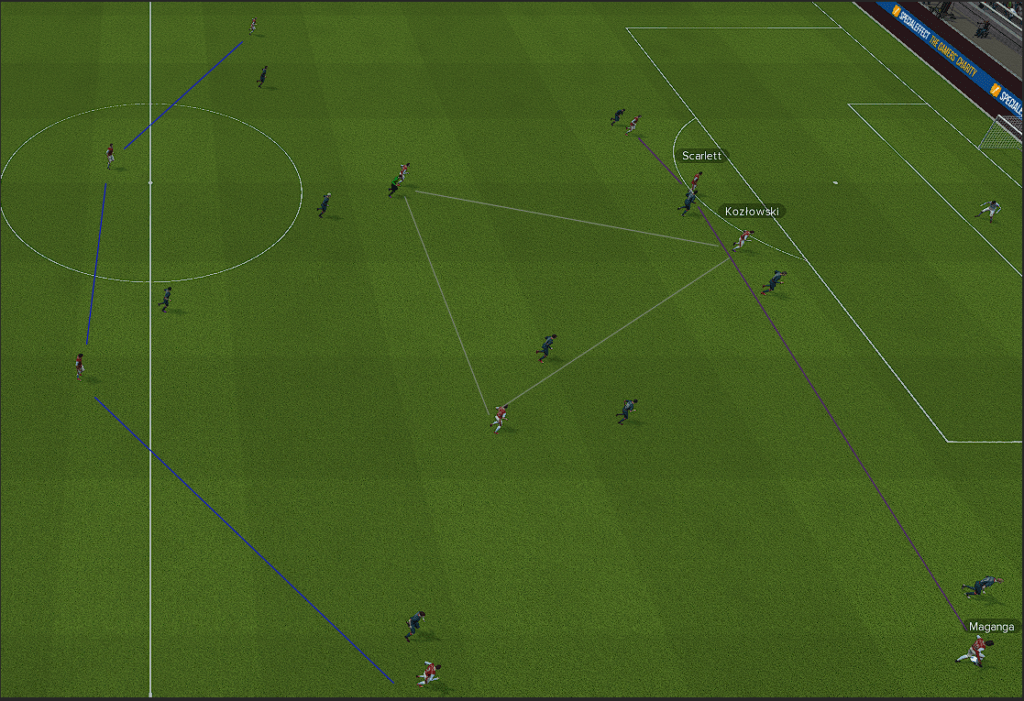
The Attacking Midfielder is now ahead of the striker and this is when the system turns into a 4-2-4. But if you look closer to this, the wing backs are closer to the central midfielders in terms of how high they are up the pitch, compared with the defenders.
Due to my right Inside Forward being our highest player up the pitch, their left back has had to drop deeper. Meaning our Striker and Attacking Midfielder are all onside, creating a perfect pocket to create an opportunity. If we lose the ball here, we are still safe from a counter, with 6 players behind the ball.
From here, the cross comes up and our Attacking Midfielder takes a touch and allows the ball to go in front before slotting passed the keeper.
Roles and Duties
I often swapped the mentality, but kept a base of Balanced. When playing better teams, I normally switched to cautious. Depending how the game was playing out, I would make slight adjustments to the mentality to give us an upper hand. This is how I set up the Counter Attacking 4-3-3 team.

Goalkeeper (D)
Our goalkeeper is simply to stop chances, and distribute to the feet of our defenders. If you have a tall Attacking Midfield, you can use this as an outlet. It works, trust me.
Wing Back (S)
Both our Wing Backs are expected to perform the same. Win the ball back, press, intercept and make tackles if and when required. They aren’t there to create chances in terms of assists, but to be involved more with the transitional phases of play.
Central Defender (D)
Exactly what it says on the tin, be the last line of defence. Keep it simple, but reduce the opposition to as few chances as possible. They aren’t there to start phases of play, but be more direct. As you seen from the above video, they are excellent for this. They do need to be good on the ball, as often they are one of the players who make the most passes.
Ball Playing Defender (D)
Although we have a Deep Lying Playmaker, this is an even deeper playmaker. More often than not, the team are relying on this player to make things happen. A forward thinking, defender with intent to create and progress. It’s not a passing style of play, but it definitely is about waiting for the right opportunity. Partner this with the defensive responsibilities and you have yourself a key player within the team.
Ball Winning Midfielder (D)
This role is a bit of an unsung hero, mainly because it’s often the lowest average rating position. But that’s not to say that it’s not important. This role is about picking up the ball where they can, and offering the defence that little extra defensive cover. Often being a defence line when the four players up front push on, it’s essential someone sits here.
Deep Lying Playmaker (S)
I wanted a midfielder who would create chances, but be involved in the phases of play. I wasn’t expecting our Deep Lying Playmaker to have 18 assists in 43 games. Especially when the team sets up in a 4-2-4 formation, with the two Central Midfielders sitting deeper. One of the highest performing players within the team, with over the top through balls and clear direct play.
Inside Forward Left (S)
The Jack of all trades, master of none role. Not in a nasty way either. I just mean this role did a bit of everything. If you could pinpoint what they were best at, you would be limited. They create, score, contribute. I didn’t want this role to be a scoring role, because it would leave us weaker defensively, with the overload. Often playing this as a left footed player, so they were more direct when cutting inside.
Attacking Midfielder (A)
My favourite role this season, and the previous season. Both working slightly different. The original AM (A) was focused on getting others involved. As well as using their physicality to bully defenders and find pockets of space. In the current system, it acts as a Second Striker, causing opposition problems, and getting in between pockets of space. Not only does this role score goals but it gives defenders headaches as they push beyond the striker.
Inside Forward Right (A)
The more attacking of the two Inside Forwards and performances show this. Creating and scoring goals is the focus here, and that’s exactly what this does. 18 assists for one of my players, with 8 goals over the course of the season. It acts as a different avenue to get chances, whilst sitting narrow to create a three man overload in attack.
Advanced Forward (A)
It took my striker 5 games to score. I was analysing the system and thought once it clicks, it will. Fast forward to the end of season and our Striker has scored 56 goals. With a 54% chance of hitting the target. I looked at this in more depth that I realised out of the 116 shots he took, 56 were goals. 48.28% of shots on target turned out to be a goal. This is phenomenal. This matches closely to Erling Haaland.
Summary of Counter Attacking 4-3-3
Having used this system for three seasons, I have to come to conclusion it suits my play style perfectly. This system worked when I was fighting to survive in a league I was expected to be relegated. It also suited my Aston Villa team who have just won the FA Cup and Championship. It has allowed me to be solid at the back, whilst scoring. In all three seasons this was used, my Goalkeeper had the most clean sheets. The roles I have used, for me, compliment themselves and give different attacking outlets.
The AM (A) is the most influential player in this system in terms of creating and scoring. The system works in a way that if he was tall, he’d play differently to if he was more technical. Evolving from Wingers to Inside Forwards were effective, but not crucial. I didn’t have a tall striker or Attacking Midfielder to get on the end of crosses. It’s all about improvising, creating chances that suit the players you have.
Chopping and changing, but keeping the core concepts allowed me to flourish in the Championship. It also allowed me to build foundations in Poland, in which created success. The Counter Attacking 4-3-3 was a formation that seems generic, but when broken down, changes. In attack it often doubled up as a 4-2-4 and in defence, often looked like a 5-2-3. Allowing the team to press higher, but not too high and using my attack as my first line of defence allowed me to concede as few shots as possible.
Squad rotation is key. In the Championship I was playing Sat,Wed and Sat. This meant that our players were often tired, rotating players and allowing opportunity was key. Young players were getting games to stay fit, and to offer a route into the first team. The same happened in Poland, the team was rotated, but my recruitment remained the same. The objective was tall, physical Attacking Midfielders and Strikers. It’s more about adapting and evolving as time goes on.
If you enjoyed this, then make sure to follow us on Twitter and Facebook to keep up with all Dictate The Game content. Thank you for reading!
Other articles you may enjoy:
10 thoughts on “How I Won The League With a Counter Attacking 4-3-3 – FM23”
Any PI’s? Bud
No Player Instructions at all. However, you are more than welcome to use them.
Thanks for the detailed explanation. i will try this in my turkish league career
You are more than welcome. Best of luck!
Do you added some instructions to specific players?
Hi ! Really great tactic you’ve put up here !
I just wanted to give you a feedback as I’ve been using your tactic in my save.
To give some context, I’m playing Schalke and I’m in my second season. Finished 5th during my first. I started using the tactic right before my 2nd season’s first game so no preseason to get familiar with it.
After 4 draws (against Leipzig and Dortmund nevertheless), things started to look better offensively.
I’m currently in January and I’m top of the league, top of my EL group and haven’t lost a single game !
Sure my team has improved in quality (current lineup is Grabara ; M.Aydin, Greiml, V.Gomez, Truffaut ; Klauɓ, Flick ; Wanner, Iliev, Zalazar ; Beljo) but we were predicted to finish 8th.
The playing style has been absolutely fantastic. I’ve been looking for a while to find/create a tactic with a fluid counter attacting football like that !
To conclude this (maybe a bit too long) feedback, thank you for this tactic ! Really glad you decided to wrote an article about it ! Cheers !
What was the difference is roles or instructions between the Villa version and the version played at Radomiak Radom?
Hi! When setting up this formation, the game recognises it as a 4-2-3-1.
Is that something you faced, or did you just rename the 4-2-3-1 to a 4-3-3?
I am trying this system currently with some tweaks, adapting to my team.
I have pulled back both midfielders in the DM slot, having the DLP take a segundo volante role, as i feel that in this match engine it might work even better. Also i am changing the two inside forward roles according to who i have on the pitch, as some of my players are better inside wingers.
So far, i’m liking how it plays out, i was looking for something like this so thank you for the inspiration with this read
But won’t the high defensive leave space for the opponents fast wingers